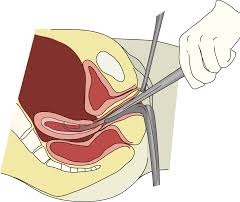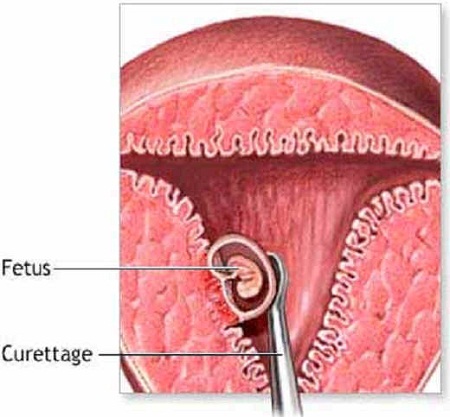
Dilatation and Curettage, image : Wikipedia
Dilatation and Curettage or D&C is the procedure of opening cervix and surgical removal of part of the lining uterus and the contents of uterus by scraping and scooping (curettage). The reason that you may need a D&C is to remove tissue in the uterus during or after a miscarriage or abortion to help prevent infection or heavy bleeding, and to diagnose or treat abnormal uterine bleeding. The D&C may help diagnose fibroids, polyps, endometriosis, hormonal imbalance or uterine cancer. Most women cannot be actively trying to conceive right after D&C procedure. They have to wait until the bleeding stops which could be anywhere from 2-6 weeks after the D&C and wait until they’re ovulating so they can get pregnant.
The first step in the D & C procedure involves dilating the cervix. This can be accomplished by inserting a slender rod, known as a laminaria, into the cervix. Over a period of several hours the rod expands while absorbing cervical fluid. As a result the cervix will dilate. The surgeon may also apply a gel to soften the cervix, further assisting with dilation.
Dilatation and Curettage Procedure
The actual procedure begins with the patient being placed in stirrups while she is lying on her back. An instrument will be inserted to hold the cervix in position and then a speculum will be inserted into the vagina. Further dilation of the cervix is then accomplished by the insertion of rods of slightly increasing diameter. The surgeon will now be able to access and remove all foreign tissue that is lining the uterus wall. This accomplished either with the aid of an instrument called a curette or by suction.

Dilatation and Curettage, image : Hisbranches.org
The procedure does carry some risks but these are rare. They include uterine bleeding, infection and perforation of the uterine wall. There is also the possibility that the procedure may result in scarring of the walls of the uterus, which may lead to the development of Asherman Syndrome (AS).
In the absence of complications, post-surgery recuperation is rapid. The patient should be able to leave the hospital within just a few hours. They will, however, be required to rest for a day or two at home. There is usually minimal pain after a D & C procedure, although some spotting is common. Indications that things are not right following the procedure include heavy vaginal bleeding, fever, abdominal pain and a pungent smelling vaginal discharge. Patients who notice any of these symptoms should contact their medical professional immediately.
Following a D & C operation it will take some time for the cervix to return to its normal size. During this time their is a greater chance of vaginal bacteria entering the cervix and causing infection. During this time, the uterus will also be constructing a new lining. During this period it is important not to insert anything into the vagina. The resumption of sexual activity and the use of tampons should be guided by the patient’s medical professional.
More at : Wikipedia and Betterhealth.vic.gov.au
Related post :
1. Blocked Fallopian Tubes
2. Ovarian Cyst Symptoms



 Saving...
Saving...